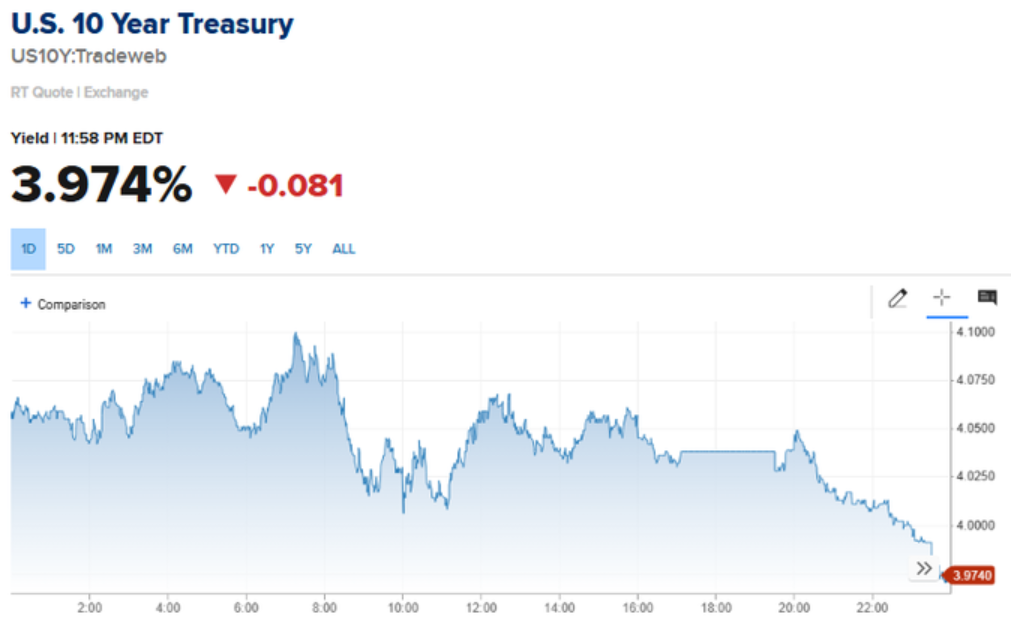US Treasury Yield has dropped below 4% for the first time since October.
This signals a possible change in Federal Reserve (Fed) policy, arousing renewed interest in Bitcoin (BTC) and other risk assets.
Treasury and Bitcoin Yields: a risk rotation?
As outstanding By the Barchart financial market aggregator, this fall reflects the growing economic uncertainty. Specifically, it suggests increased recession fears and growing speculation that the Fed can change to rate cuts earlier than expected.

A drop in treasure yields reduces the attractiveness of traditional assets of safe haven, such as titles, often encouraging investors to seek higher returns elsewhere.
Historically, Bitcoin and Altcoins have benefited from such changes, as the fall in real income increases liquidity and risk appetitis. Crypto analyst Dan Gambardello emphasized this connection. He noted that lower income is positive for Bitcoin, aligning with the expectations that a more tolerant Fed will boost liquidity in risky assets.
The irony is that when income falls, there is less reason to be in securities’ – and ultimately more reason to seek returns from risk assets such as BTC and Alts. This is why you see the risk bulls get excited when 10 -year income starts to fall, he stated.
In addition, Bitmex’s founder and former CEO Arthur Hayes pointed out that 2-year treasure performance fell sharply after the introduction of new tariffs. He said this reinforced the expectation of the market of imminent cuts at Fed rates.
We need Fed’s flexibility, 2 -year -old treasure yield plummeted after the fare announcement because the market is telling us that the Fed will cut soon and possibly restart QE to counterbalance the negative economic impact, Hayes shared No X (former Twitter).
Hayes earlier designed that Bitcoin could shoot up to $ 250,000 if quantitative loosening (QE) returns to economic recessions.
The Trump factor: tariffs and market volatility
In addition, analysts have linked the drop in income to economic uncertainty triggered by Trump’s aggressive strategy. As Gambardello noted, these tariffs encouraged a security search, raising prices of securities and reducing income.
This trend aligns with Trump’s broader economic approach to weaken the dollar and reduce interest rates, which historically benefits Bitcoin. During his first term, Trump often wished a weaker dollar and lower interest rates to boost exports and economic growth. He also pressured the Fed to cut rates several times.
Another analyst, Kristoffer Kepin, pointed out that the M2 monetary offer is growing. This reinforces expectations of liquidity increase entering the market. This capital influx can flow to Bitcoin and Altcoins as investors seek value alternatives amid economic turmoil.
Despite Bitcoin’s high potential, Goldman Sachs has recommended gold and Japanese yen as preferred protections against US recession risks. Specifically, the bank cited its historical performance in risk aversion environments.
Iene offers investors the best exchange rate protection if the chances of a US recession increase, Bloomberg reportedciting Kamakshya Trivedi, Global Exchange Strategy Chief, interest rates and emerging markets of Goldman Sachs.
The bank expressed the same feeling about gold, raising its forecast as investors buy the yellow metal. Similarly, a Bank of America (Bofa) survey showed that 58% of background managers prefer gold as a refuge in trade war, while only 3% support Bitcoin.
Investors monitor the Fed
Meanwhile, JPMorgan has raised its probability of global recession to 60%. The multinational company of banking and financial services has attributed the increased risk to economic shock. This shock stems from the rates announced on the day of liberation.
These policies, if maintained, would probably push the US and possibly the global economy for a recession this year, wrote the chief global economic research Bruce Kasman in a note last night (3).
Kasman acknowledged that the rest of the world is possible to support a recession in the US. However, he considers more likely to occur a global recession.
As Treasury Income continue to fall and economic uncertainty increases, the Fed becomes a point of attention to investors in search of signs of a change of politics.
If liquidity rate cuts and injections are realized, Bitcoin can see substantial gains, especially as traditional assets are reevaluated. However, as experts warn, short -term volatility remains an important risk factor in the midst of these market changes.

Bitcoin was being negotiated for $ 82,993 until the publication of this text. According to Beincrypto data, cryptocurrency has recorded a modest high of 1.42% in the last 24 hours.
Exemption from liability
All information contained on our site is published in good faith and only for general information purposes. Any action that the reader takes based on the information contained on our site is at his own risk.





